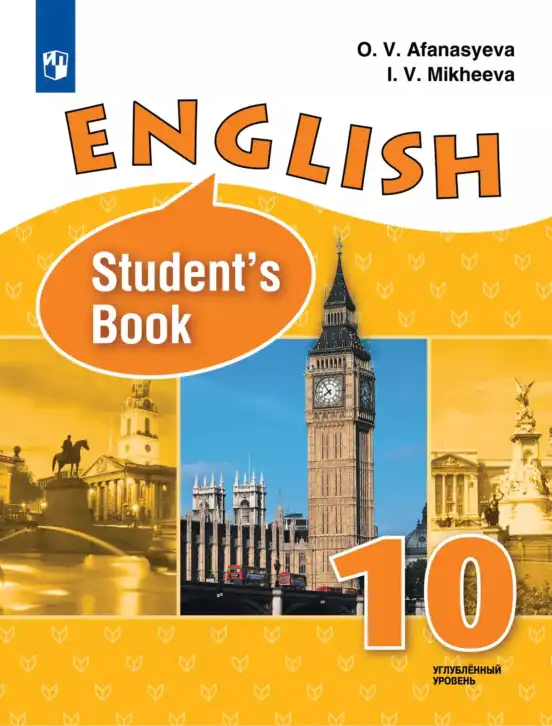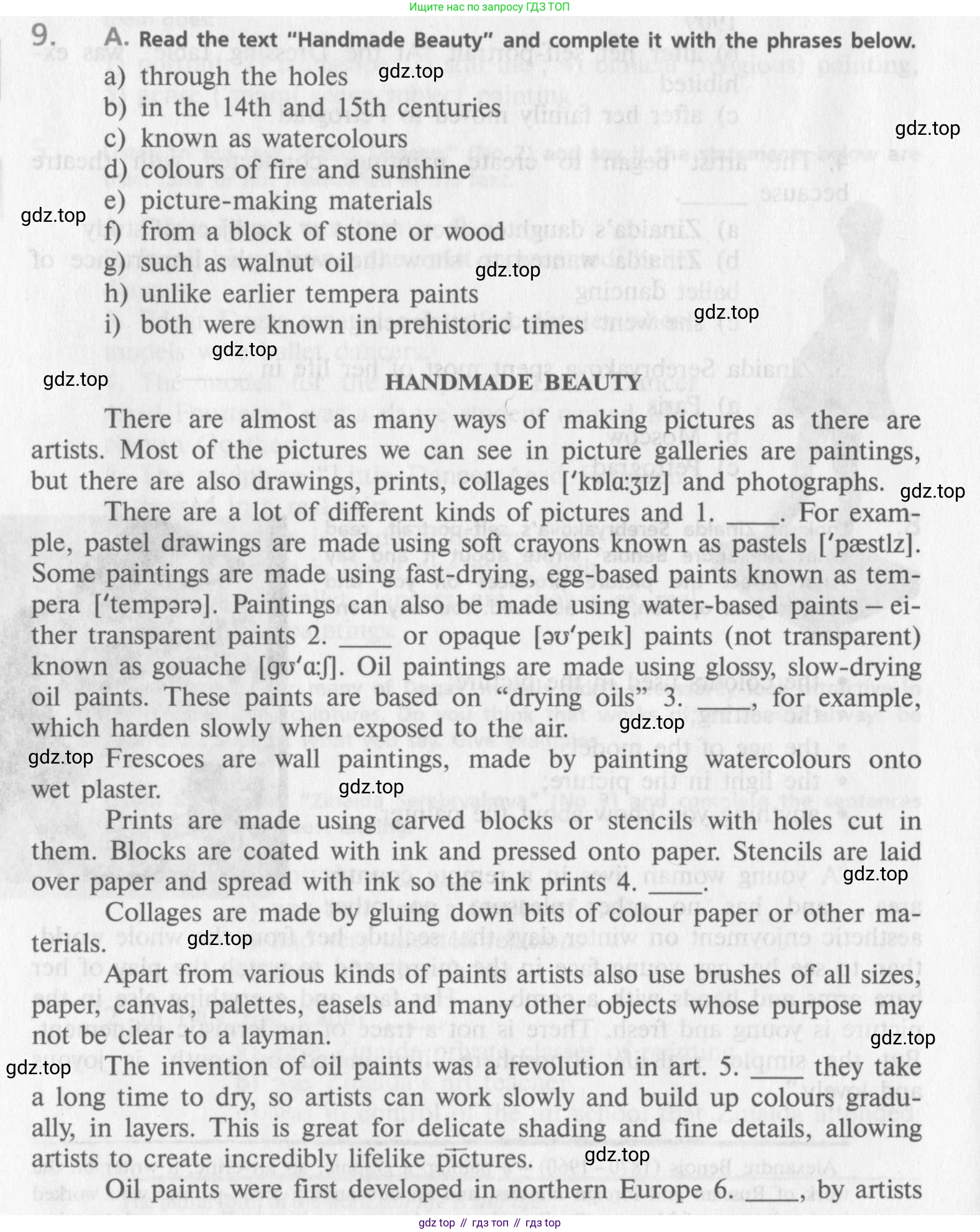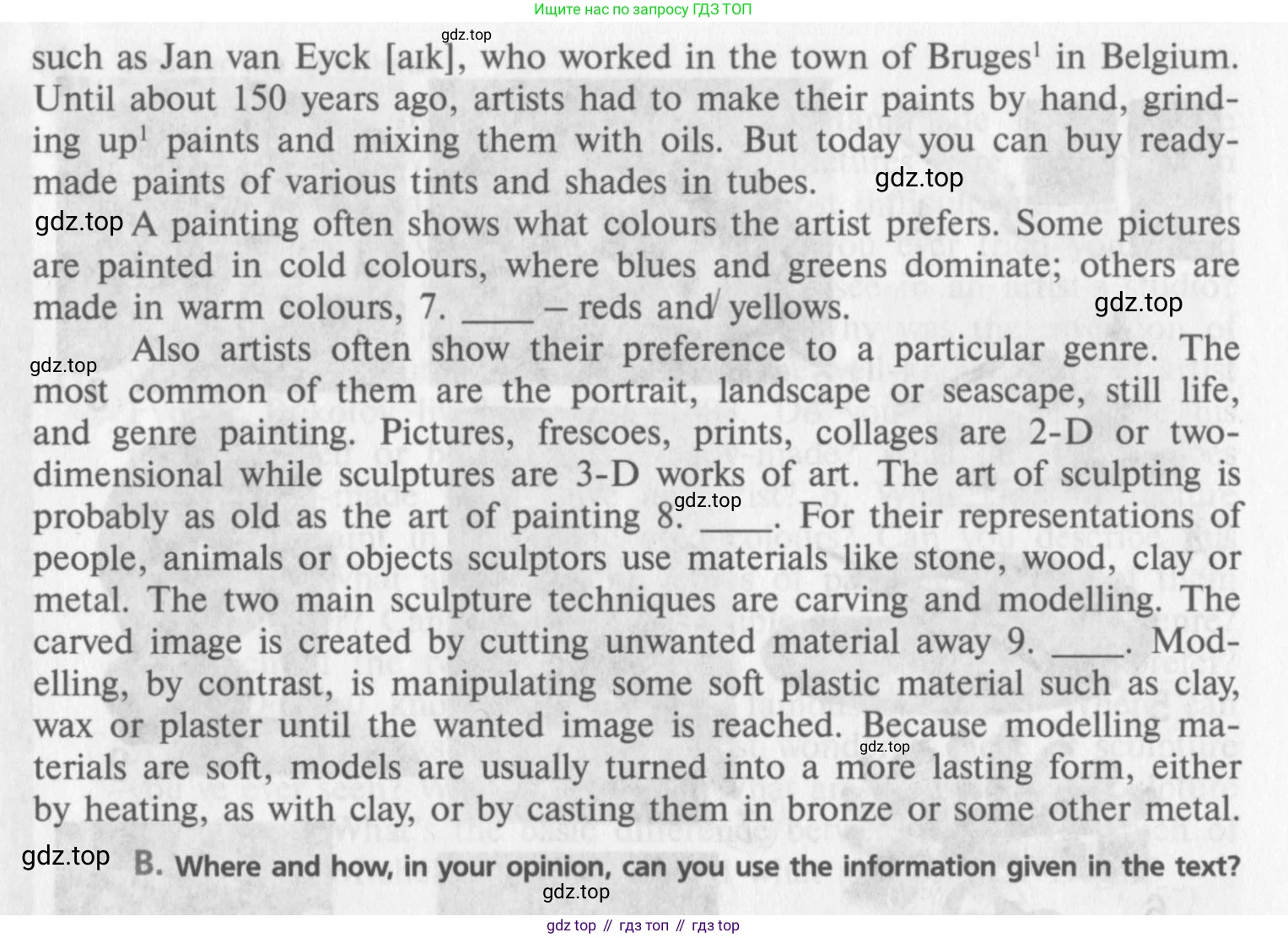Номер 9, страница 10 - гдз по английскому языку 10 класс учебник Афанасьева, Михеева

Авторы: Афанасьева О. В., Михеева И. В.
Тип: Student's book (Учебник)
Издательство: Просвещение
Год издания: 2014 - 2025
Уровень обучения: углублённый
Цвет обложки: белый, оранжевый с Биг Беном
ISBN: 978-5-09-027690-0
Популярные ГДЗ в 10 классе
Unit 1. Man the Creator. Reading - номер 9, страница 10.
№9 (с. 10)
Условие. №9 (с. 10)
скриншот условия


9. A. Read the text "Handmade Beauty" and complete it with the phrases below.
a) through the holes
b) in the 14th and 15th centuries
c) known as watercolours
d) colours of fire and sunshine
e) picture-making materials
f) from a block of stone or wood
g) such as walnut oil
h) unlike earlier tempera paints
i) both were known in prehistoric times
HANDMADE BEAUTY
There are almost as many ways of making pictures as there are artists. Most of the pictures we can see in picture galleries are paintings, but there are also drawings, prints, collages ['kɒlɑ:ʒɪz] and photographs.
There are a lot of different kinds of pictures and 1. ____. For example, pastel drawings are made using soft crayons known as pastels ['pæstl𝕫]. Some paintings are made using fast-drying, egg-based paints known as tempera ['tempərә]. Paintings can also be made using water-based paints – either transparent paints 2. ____ or opaque [oʊ'peɪk] paints (not transparent) known as gouache [ɡʊ'ɑ:ʃ]. Oil paintings are made using glossy, slow-drying oil paints. These paints are based on "drying oils" 3. ____, for example, which harden slowly when exposed to the air.
Frescoes are wall paintings, made by painting watercolours onto wet plaster.
Prints are made using carved blocks or stencils with holes cut in them. Blocks are coated with ink and pressed onto paper. Stencils are laid over paper and spread with ink so the ink prints 4. ____.
Collages are made by gluing down bits of colour paper or other materials.
Apart from various kinds of paints artists also use brushes of all sizes, paper, canvas, palettes, easels and many other objects whose purpose may not be clear to a layman.
The invention of oil paints was a revolution in art. 5. ____ they take a long time to dry, so artists can work slowly and build up colours gradually, in layers. This is great for delicate shading and fine details, allowing artists to create incredibly lifelike pictures.
Oil paints were first developed in northern Europe 6. ____, by artists such as Jan van Eyck [aɪk], who worked in the town of Bruges¹ in Belgium. Until about 150 years ago, artists had to make their paints by hand, grinding up¹ paints and mixing them with oils. But today you can buy ready-made paints of various tints and shades in tubes.
A painting often shows what colours the artist prefers. Some pictures are painted in cold colours, where blues and greens dominate; others are made in warm colours, 7. ____ – reds and yellows.
Also artists often show their preference to a particular genre. The most common of them are the portrait, landscape or seascape, still life, and genre painting. Pictures, frescoes, prints, collages are 2-D or two-dimensional while sculptures are 3-D works of art. The art of sculpting is probably as old as the art of painting 8. ____. For their representations of people, animals or objects sculptors use materials like stone, wood, clay or metal. The two main sculpture techniques are carving and modelling. The carved image is created by cutting unwanted material away 9. ____. Modelling, by contrast, is manipulating some soft plastic material such as clay, wax or plaster until the wanted image is reached. Because modelling materials are soft, models are usually turned into a more lasting form, either by heating, as with clay, or by casting them in bronze or some other metal.
B. Where and how, in your opinion, can you use the information given in the text?
Решение. №9 (с. 10)


Решение 2. №9 (с. 10)
A. Прочитайте текст "Рукотворная красота" и дополните его фразами, приведенными ниже.
B. Где и как, по вашему мнению, вы можете использовать информацию, данную в тексте?
Ответ:
A.
1. (e) picture-making materials (материалы для создания картин)
2. (c) known as watercolours (известные как акварель)
3. (g) such as walnut oil (такие как ореховое масло)
4. (a) through the holes (через отверстия)
5. (h) unlike earlier tempera paints (в отличие от более ранних темперных красок)
6. (b) in the 14th and 15th centuries (в 14-м и 15-м веках)
7. (d) colours of fire and sunshine (цвета огня и солнечного света)
8. (i) both were known in prehistoric times (оба были известны в доисторические времена)
9. (f) from a block of stone or wood (из глыбы камня или дерева)
B.
I think this information can be useful for a school report on the history of art. Also, when I visit a museum or an art gallery, I can try to understand the techniques the artists used. It might also help if I decide to try painting myself, as I now know the difference between various paints and materials.
Я думаю, эту информацию можно использовать для школьного доклада по истории искусств. Также, когда я пойду в музей или художественную галерею, я смогу попытаться понять, какие техники использовали художники. Это также может помочь, если я решу сам попробовать рисовать, так как теперь я знаю разницу между различными красками и материалами.
Другие задания:
Помогло решение? Оставьте отзыв в комментариях ниже.
Присоединяйтесь к Телеграм-группе @top_gdz
ПрисоединитьсяМы подготовили для вас ответ c подробным объяснением домашего задания по английскому языку за 10 класс, для упражнения номер 9 расположенного на странице 10 к Учебник (Student's book) 2014 года издания для учащихся школ и гимназий.
Теперь на нашем сайте ГДЗ.ТОП вы всегда легко и бесплатно найдёте условие с правильным ответом на вопрос «Как решить ДЗ» и «Как сделать» задание по английскому языку к упражнению №9 (с. 10), авторов: Афанасьева (Ольга Васильевна), Михеева (Ирина Владимировна), ФГОС (старый) углублённый уровень обучения учебного пособия издательства Просвещение.




















